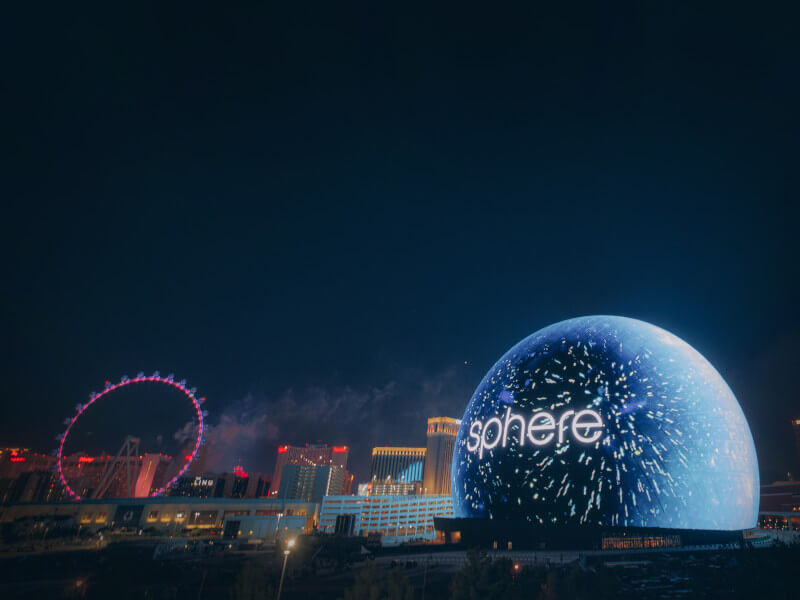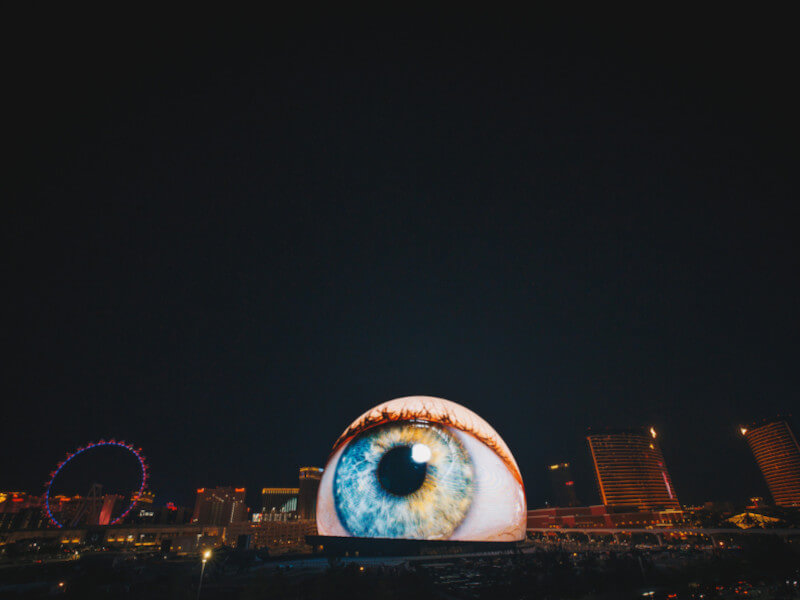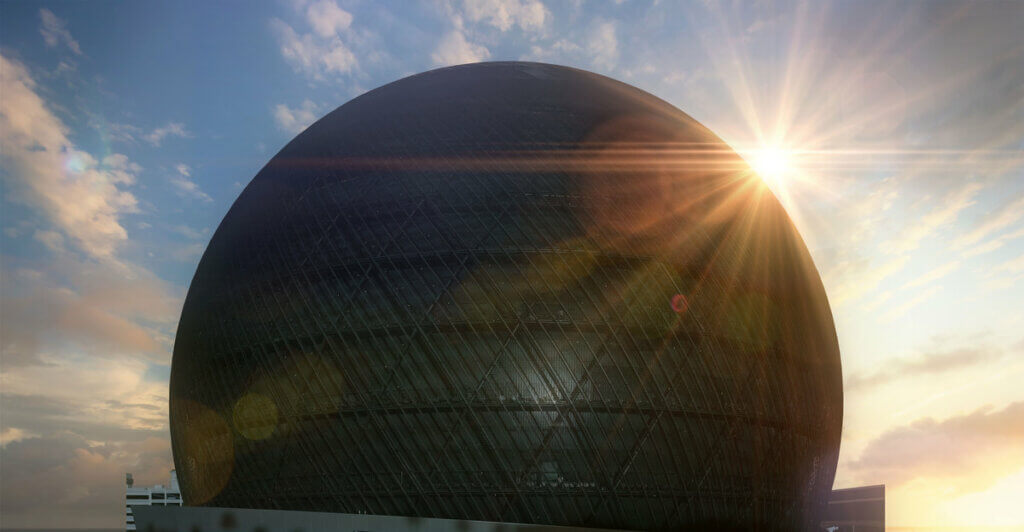Las Vegas. The city of bright lights and even brighter dreams.
Extravagant architecture, iconic landmarks, and casinos reign supreme. It’s a city where anything and everything seems possible, its strip and streets showered in pop culture references and dripping in god-like fame.
Oh, and there’s a new addition to this most iconic of skylines is turning heads and capturing hearts—the Las Vegas Sphere.
When Bono, The Edge, and Adam Clayton emerged onto the stage on Friday, 29th September, to play the opening night of their U2: ‘UV Achtung Baby Tour’—the first of 25 shows at the Sphere—it signaled the start of a new era of entertainment.
The Guardian described it as “utterly astonishing,” while Variety called it “spectacular.” But, some critics had reservations about whether the overwhelming sensory experience overshadowed the performance.
YouTube videos revealed Bono’s shaky vocals struggling to compete with the extravagant visuals. Others felt queasy from the overall experience.
Nonetheless, the general reaction to the show was overwhelmingly positive. In a thoughtful article in the New York Times, Jon Caramanica highlighted Las Vegas’s unique blend of banality and hyperreality, noting that it creates a space where the “simulacrum of glamor available to everyone ensures no one gets the real thing,” echoing a theme from ‘Achtung Baby’s’ second track.
U2’s creative director, Willie Williams, said the show has “set the world on fire”, and he’s not wrong.
A star-studded list of A-list celebs, including Matt Damon, Paul McCartney, LeBron James, and Andre Agassi, were just a handful of the 18,000 in attendance.
But this is just the beginning for a venue that The Telegraph believes “will have an impact on the whole of live entertainment”, not just music.
What is the Sphere?

Let’s start with the basics. Located just a block from the famous Las Vegas Strip, the Sphere has smashed its way into the record books as the largest spherical structure ever built.
With an estimated cost of a jaw-dropping $2.3 billion, it also holds the title for the most expensive entertainment venue in Las Vegas’ history.
Built by Madison Square Garden Entertainment, the Sphere proudly holds the title of the world’s largest spherical structure. Standing at an impressive 366 feet tall and stretching 516 feet wide, this partially hollow arena is so spacious that it could comfortably accommodate the entire Statue of Liberty from its base to its torch.
Inside the Sphere, you’ll find a massive bowl-shaped theater with a stage positioned at the bottom level, flanked by what is touted as the world’s giant and highest-resolution LED screen. This screen wraps around the audience, providing a captivating visual experience that can fill your entire field of vision, depending on your seat location.
The LED screens, both inside and outside the building, were designed and constructed by Montreal’s Saco Technologies. On the exterior, Saco installed 1.2 million LED pucks spaced 22.5 centimeters apart, forming the Exosphere.
Each puck has 48 LED diodes that showcase an astounding 256 million colors. This exterior screen serves as a billboard to promote events and video games, but it also adds a touch of flair to the Las Vegas skyline.
It sometimes transforms into various shapes, such as a basketball, a globe, an eyeball, or even a smiling yellow emoji.
This is inside the Sphere in Las Vegas.
This may be the most insane concert venue ever built pic.twitter.com/We3pcO3lEX
— Alex Cohen (@anothercohen) September 30, 2023
As for the interior, the Sphere can accommodate approximately 18,000 people, with the LED screen wrapping around and extending over the audience. This screen comprises individual panels, collectively creating an astonishing 170 million pixels. It truly stands as the highest-resolution screen of any kind in the world.
With its impressive size, cutting-edge LED technology, and visually stunning displays inside and out—the Sphere offers an unparalleled immersive experience for its guests.
This architectural marvel will leave audiences in awe, whether it’s the captivating exterior displays or the breathtaking visuals within the theater.
How did they build the Sphere?

Madison Square Garden Entertainment commissioned the renowned global architecture firm Populous to design the Sphere.
When the project was first announced in 2018, its creators had one goal: to redefine the future of live entertainment.
They knew that in a city already bursting at the seams with music venues and arenas, the folks at Madison Square Garden Entertainment had to offer an experience that couldn’t be replicated elsewhere.
Populous is well-known for its expertise in designing sporting facilities, arenas, and convention centers worldwide, with some of its notable projects including the Coca-Cola Arena in Dubai, the Zayed Sports City Stadium in Abu Dhabi, and the Emirates Stadium, and Etihad Stadium in the United Kingdom.
Building this massive concept required severe brainpower and a fair share of heavy lifting. The engineers had to crunch intricate calculations and use specialized equipment to transport one of the largest cranes in the world.
The item in question was shipped from Belgium via sea. Due to its size, it required the use of large cranes during the transportation process. The shipment arrived at Port Hueneme, California, and was transported to Las Vegas using 120 tractor-trailers.
The interior of this remarkable structure has been carefully crafted to provide a vast, open space. Thanks to the ingenious engineering of Severud Associates, a combination of concrete and steel elements such as ring beams, girders, and trusses have been employed. These elements support a massive 13,000-ton steel roof encompassed by a gridded steel exoskeleton.
A range of advanced features have been integrated into the venue to heighten its sensory impact. Firstly, a vast soundstack consisting of 167,000 speakers is concealed behind the LED screen made up of 64,000 separate LED tiles. This system employs Holoplot technology, which enables sound to be directed precisely to specific sections of the theater.
Plus, haptic features are included, including seats that can move, rock, and vibrate to harmonize with the performance. Additional sensory experiences, such as wind, smells, and temperature changes, have been introduced to provide a fully immersive, fourth wall-breaking experience for the audience.
Nearly every surface inside the theater bowl has been designed to absorb or diffuse sound to avoid audio echoes and other unwanted distractions. Reflectors have also been installed at strategic locations to help target specific sounds from the show. Overall, the combination of cutting-edge audio and sensory technologies creates an unforgettable experience for attendees.
They needed extra muscle for the crucial components, like a steel compression ring weighing as much as two Boeing 757s. But all that hard work is just the beginning. Holding up to 18,000 people, the Sphere is perfect for concerts, award shows, product launches, and even esports tournaments.
The concept was so well-received that plans are already in motion to build similar structures in London and other cities around the globe. So this iconic Sphere is about to bring some Vegas magic to the rest of the world.
What else is on at the Sphere?

One week after U2 opened the venue spectacularly, the Sphere once again proved its new position as the world’s most exciting entertainment venue with the premiere of ‘Postcards from Earth’—its inaugural film directed by Darren Aronofsky.
In cinematic experiences, the Sphere has definitively pushed the boundaries of size and immersion, proving that there are no limits. The film embraces the vastness of the venue with breathtaking visuals.
The dome, towering 366 feet above the ground, showcases expansive skies that fill the entire space, creating a mesmerizing blue-screen effect.
This 50-minute movie takes the audience on an interstellar journey, enveloped by the wrap-around screen that perfectly complements the science-fiction narrative.
But, the film also incorporates moments of intimacy, as the proprietary Big Sky cameras zoom in on minuscule objects like a praying mantis, reminding viewers to appreciate the world’s small wonders.
True to Aronofsky’s signature style, “Postcard From Earth” goes beyond mere spectacle, delving into more profound themes. The story follows two astronauts who embark on a mission to a distant planet, driven by an underlying crisis unfolding on Earth.
Ultimately, the film accomplishes its goal of serving as a love letter to our planet, encouraging audiences to cherish and protect it.
The Sphere and “Postcard From Earth” combine technical brilliance with a thought-provoking narrative, providing a movie experience that aims to leave viewers with a heightened sense of environmental stewardship.
It truly feels like the start of a new era of storytelling and visuals.
Part of The Sphere Experience, those fortunate enough to witness the shows are guided by a team of five interactive humanoid robots known as Aura. Each Aura robot represents a different aspect of human capability, including connection, creativity, innovation, longevity, and productivity.
These robots utilize advanced robotic mechanics and artificial intelligence to provide an engaging and personalized journey through Sphere.
One of the key highlights of the experience is the Sphere Immersive Sound, powered by HOLOPLOT technology. Aura will lead guests through an interactive demonstration showcasing the innovative beamforming technology. This jaw-dropping tech enables the simultaneous delivery of unique audio content to specific locations, allowing guests to hear different languages or instruments.
Sphere Immersive Sound sets a new standard in concert-grade audio systems, utilizing cutting-edge 3D audio beamforming and wave field synthesis techniques to provide targeted, crystal-clear, and uniform audio to every seat in the venue.
In addition to the immersive sound experience, the Atrium of Sphere offers a range of captivating technological exhibits. These include a 50-foot-high holographic installation inspired by the themes of “Postcard from Earth”—artwork created using machine learning techniques, LED displays, and a 360-degree avatar capture that virtually places guests atop Sphere.
Overall, the Sphere Experience combines state-of-the-art technology with interactive robot guides and immersive audiovisual displays to create an enchanting and unforgettable journey for visitors.
What does the future hold for the Sphere?

All shows or performances have yet to be announced beyond U2’s final show at the Sphere on Saturday, 16th December. But, 2024 is sure to usher in a stacked calendar.
Whatever the show, it’s likely to provide a feeling like any other, judging by the early reviews and thoughts. Of course, there are teething problems, as evidenced by some technical issues during U2’s opening night performance. There are also a few doubts over the nauseous nature of the immersion, but they seem minor in the grand scheme of things.
The Sphere is poised to revolutionize the entertainment industry and represent the future of immersive experiences. The film “Postcard from Earth” showcased groundbreaking 18k projected images, a visual quality never seen before.
At the film’s premiere, director Darren Aronofsky expressed his awe at the unprecedented level of detail, highlighting the staggering amount of data involved—500,000 gigabytes. The potential impact on the human brain from such a visually stunning encounter remains an intriguing question.
The Sphere’s cutting-edge technology and unprecedented visual capabilities pave the way for an unparalleled entertainment experience that pushes the boundaries of what the human mind can comprehend.
There has been talk of the Sphere going international, with London a touted destination for the following ‘Crystal Ball’ structure. But, residents of the planned location in Stratford, East London, have informed those in charge of their discontent.
Despite being approved by planning officials last year, free blackout blinds intended to mitigate light pollution from the numerous LED screens covering the Sphere have yet to be well received.
Numerous objections were raised in 2019 regarding the proposed development. Concerns included fears that the venue would cast shadows over nearby homes, increase pollution, and cause significant light pollution during nighttime. The objections reflect the local community’s apprehension towards the potential negative impacts associated with the project.
While plans for MSG Sphere London were approved last year, construction is pending approval from Sadiq Khan, the Mayor of London, and Michael Gove, the Secretary of State for Leveling Up.
Despite the negativity surrounding the proposed London site, MSG boss James Dolan says the company’s controversial MSG London Sphere scheme is “moving forward”, and the plan is “to build more Spheres all over the world.”
Watch this (sensory) space.
All photos credit: Sphere Entertainment






